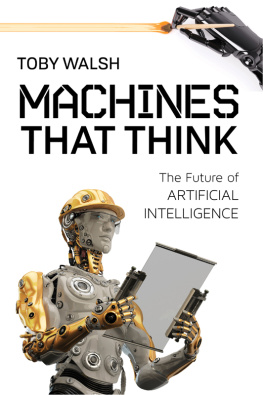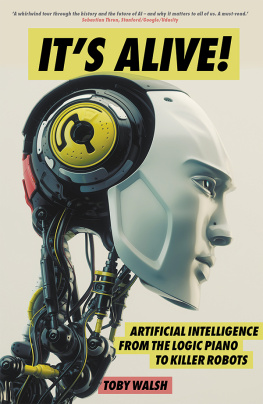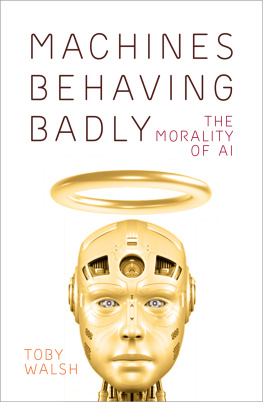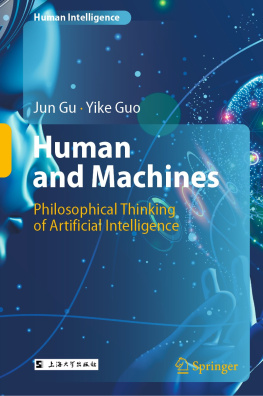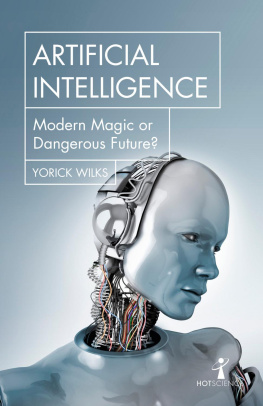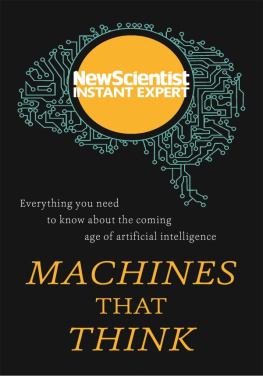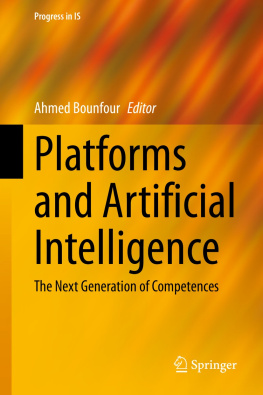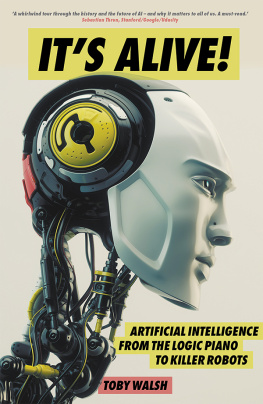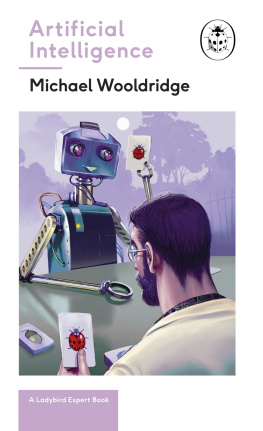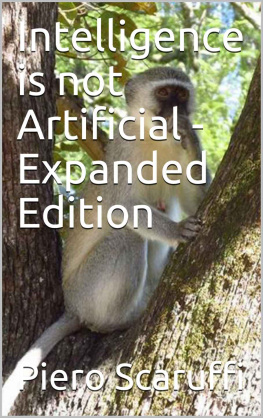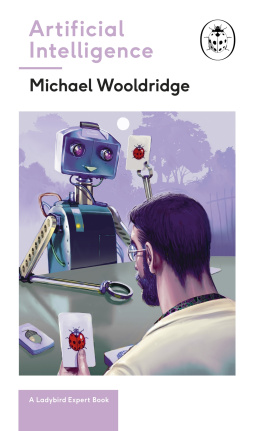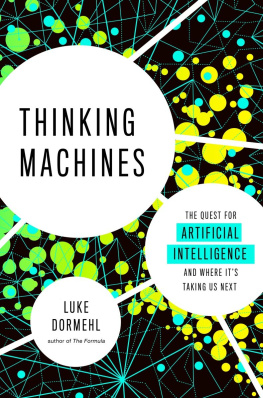
TOBY WALSH has spent his life dreaming and researching about machines that might think in universities around the world. He was named by the Australian newspaper as one of the hundred rock stars of Australia's digital revolution. He is a Professor of Artificial Intelligence at UNSW and at Data61, Australia's Centre of Excellence for ICT Research. He has been elected a Fellow of the Australian Academy of Science and of the Association for the Advancement of Artificial Intelligence. He has also won a number of prizes, including the Humboldt Research Award. He has held research positions in Australia, England, France, Germany, Ireland, Italy, Scotland and Sweden.
He regularly appears on TV and radio talking about the impact of AI and robotics. He also writes frequently for print and online media such as New Scientist, American Scientist and Cosmos. His Twitter account, @TobyWalsh, has been voted one of the top ten to follow to keep abreast of developments in AI. He has given talks in venues like CeBIT, TEDx and the World Knowledge Forum, Asia's answer to Davos. He has spoken at the United Nations and elsewhere about the need to ban lethal autonomous weapons (aka killer robots). You can read more at his blog, http://thefutureofai.blogspot.com.

J.S. Aikins, J.C. Kunz, E.H. Shortliffe & R.J. Falat (1983) PUFF: An expert system for interpretation of pulmonary function data. Computers and Biomedical Research, 16: 199208.
P. Allen & M. Greaves (2011) The Singularity Isn't Near. MIT Technology Review, October, pp. 765.
I. Asimov (1950) I, Robot. New York, Gnome Press.
D. Autor (2014) Polanyi's Paradox and the Shape of Employment Growth. Working Paper 20485, National Bureau of Economic Research, September.
H.J. Berliner (1980) Computer Backgammon. Scientific American, 242 (6): 6472.
N. Bostrom (2001) When Machines Outsmart Humans. Futures, 35 (7): 759764.
N. Bostrom (2006) How Long Before Superintelligence? Linguistic and Philosophical Investigations, 5 (1): 1130.
N. Bostrom (2014) Superintelligence: Paths, Dangers, Strategies. Oxford (UK), Oxford University Press.
L. Carroll (1895) What the Tortoise Said to Achilles. Mind, 4 (14): 278280.
D. Chalmers (2010) The Singularity: A Philosophical Analysis. Journal of Consciousness Studies, 17 (910): 765.
D. Cole (2004) The Chinese Room Argument. In The Stanford Encyclopedia of Philosophy. The Metaphysics Research Lab, Center for the Study of Language and Information, Stanford University.
Sequences. In Proceedings of the 17th National Conference on AI. Association for Advancement of Artificial Intelligence.
E. Dabla-Norris, K. Kochhar, N. Suphaphiphat, F. Ricka & E. Tsounta (2015) Causes and Consequences of Income Inequality: A Global Perspective. Technical report, IMF, SDN/15/13.
B. Darrach (1970) Meet Shakey, the First Electronic Person. Life, 69 (21): 5868.
P. Domingos (2015) The Master Algorithm: How the Quest for the Ultimate Learning Machine Will Remake Our World. New York, Basic Books.
H.L. Dreyfus (1992) What Computers Still Can't Do: A Critique of Artificial Reason. Cambridge (MA), MIT Press.
H. Durrant-Whyte, L. McCalman, S. O'Callaghan, A. Reid & D. Steinberg (2015) Australia's Future Workforce? Technical report, Committee for Economic Development of Australia, June.
C. Edwards (2015) Growing Pains for Deep Learning. Commun. ACM, 58 (7): 1416.
N. Ernest, D. Carroll, C. Schumacher, M. Clark, K. Cohen & G. Lee. Genetic Fuzzy Based Artificial Intelligence for Unmanned Combat Aerial Vehicle Control in Simulated Air Combat Missions. Journal of Defense Management, 6 (1).
C.B. Frey & M.A. Osborne (2013) The Future of Employment: How Susceptible Are Jobs to Computerization? Technical report, Oxford Martin School.
B. Gates (1994) The Road Ahead. New York, Viking Penguin.
I.J. Good (1965) The Mystery of Go. New Scientist, 21 January, pp. 172174.
I.J. Good (1965) Speculations Concerning the First Ultraintelligent Machine. Advances in Computers, 6: 3188.
A. Hodges (1983) Alan Turing: The Enigma. London: Burnett Books.
V. Kassarnig (2016) Political Speech Generation. CoRR, abs/1601.03313.
J.M. Keynes (1930) Economic Possibilities for Our Grandchildren. The Nation and Athenaeum (London), 48 (2): 3637 and 48 (3): 9698.
R.E. Korf (1997) Finding Optimal Solutions to Rubik's Cube Using Pattern Databases. In Proceedings of the Fourteenth National Conference on Artificial Intelligence and Ninth Conference on Innovative Applications of Artificial Intelligence, AAAI Press, pp. 700705.
R. Kurzweil (2006) The Singularity Is Near: When Humans Transcend Biology. New York, Penguin.
W. Leontief (1952) Machine and Man. Scientific American, 187 (3): 150160.
F. Levy & R.J. Murnane (2004) The New Division of Labor: How Computers Are Creating the Next Job Market. Princeton, Princeton University Press.
Z.C. Lipton & C. Elkan (2016) The Neural Network that Remembers. IEEE Spectrum, February.
J.R. Lucas (1961) Minds, Machines and Gdel. Philosophy, 36 (137): 112127.
M. Minsky (1967) Computation: Finite and Infinite Machines. New Jersey, Prentice Hall.
V. Mnih, K. Kavukcuoglu, D. Silver, A. Rusu, J. Veness, M. Bellemare, A. Graves, M. Riedmiller, A. Fidjeland, G. Ostrovski, S. Petersen, C. Beattie, A. Sadik, I. Antonoglou, H. King, D. Kumaran, D. Wierstra, S. Legg & D. Hassabis (2015) Human-level Control through Deep Reinforcement Learning. Nature, 518: 529533.
H. Moravec (1988) Mind Children: The Future of Robot and Human Intelligence. Cambridge (MA), Harvard University Press.
R. Penrose (1989) The Emperor's New Mind: Concerning Computers, Minds, and the Laws of Physics. New York, Oxford University Press.
J.R. Pierce (1969) Whither Speech Recognition? The Journal of the Acoustical Society of America, 46 (4B): 10491051.
S. Pinker (1994) The Language Instinct: How the Mind Creates Language. New York: HarperCollins.
S. Pinker (2008) Tech Luminaries Address Singularity. IEEE Spectrum, June.
D. Remus & F.S. Levy (2015) Can Robots Be Lawyers? Computers, Lawyers, and the Practice of Law. Technical report, Social Science Research Network (SSRN), December.
J. Searle (1980) Minds, Brains and Programs. Behavioral and Brain Sciences, 3 (3): 417457.
J. Searle (1990) Is the Brain's Mind a Computer Program? Scientific American, 262 (1): 2631.
B. Schiller (2016) This Japanese Novel Authored by a Computer Is Scarily Well-Written. Fast Company, March.
C.H. Townes (1999) How the Laser Happened: Adventures of a Scientist. New York, Oxford University Press.
A.M. Turing (1950) Computing Machinery and Intelligence. Mind, 59 (236): 433460.
A.M. Turing (1952) The Chemical Basis of Morphogenesis. Philosophical Transactions of the Royal Society of London B: Biological Sciences, 237 (641): 3772.
S. Ulam (1958) Tribute to John von Neumann. Bulletin of the American Mathematical Society, 64 (3).
V. Vinge (1993) The Coming Technological Singularity: How to Survive in the Post-Human Era. In H. Rheingold (ed.), Whole Earth Review. Point Foundation.
T. Walsh (2016) Turing's Red Flag. Communications of the ACM, 59 (7): 3437.
Next page
